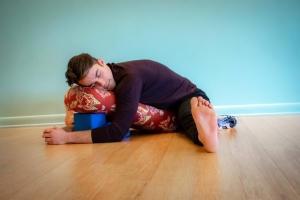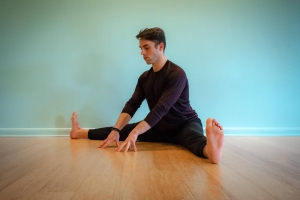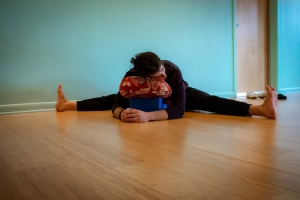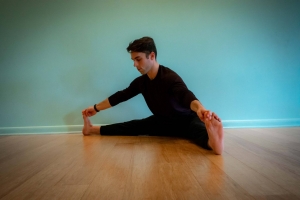Understanding Different Stretching Techniques
Written by AYC Instructor, Forrest Campbell
The practice of yoga can be described as boundless, with boundless subjects tied into it. Memorizing every single muscle, bone, node and valve in the body is not necessary to experience the beauty of asana. However, it is nice to know some science behind certain aspects of a yoga practice so that we can find the strongest versions of ourselves with a little help. Asana, in and of itself, is a vast subject. We are just going to cover a small portion relating to muscle stretching: specifically, active and passive static stretching.
Stretching Breakdown
Every single skeletal muscle in our body has at least one origin and insertion. Let’s break down what that means exactly.
The origin of a muscle is typically closest to the midline of the body and is more fixed in a contraction. In contrast, the insertion is more moveable. For example, part of our bicep muscle, the biceps brachii, attaches its origin to the part of our shoulder blade called the supraglenoid tubercle of the scapula. The insertion of this muscle is located on a bone in our forearm called the radius. Stretching creates greater distance between the origin and insertion which stretches the biceps brachii by lengthening the arm.
When we stretch muscles, our nervous system dictates how far we can go in a particular stretch. We have receptors that monitor muscle length and let us know when we are stretching too deeply. These receptors alert us with an intense, unsustainable sensation which prevents us from tearing or overstretching muscles.
It’s up to us to be persistent in our practice to find greater muscle stretch tolerance and flexibility. We need to enter stretching with a sense of repose so that our nervous system reduces its grip on a stretched muscle over time.
Muscle Tightness
Many factors can cause reduced joint range of motion, and muscle stiffness is just one piece of the puzzle. Muscle tightness, consequently, comes from increased tension from active or passive mechanisms. Habitual posture and muscle scarring are both passive ways muscles can develop tightness and spasms. Repetitive muscle contraction is an active way that tightness can occur.
Passive Static Stretching
This technique can be practiced many ways in asana, and if you’ve taken a class, you’ve probably experienced passive static stretching in at least one way. This type of stretching uses gravity and body weight as tools to facilitate muscle stretching. You can hold these stretches for up to 30 seconds (or even longer) as you allow the nervous system and stretch receptors to acclimate to each shape. The idea behind this kind of stretching is to find a sensation in the body that can be sustained with steady breath for the whole duration of a held stretch. A sense of relaxation and ease can often be felt during and after this style of stretching.
Here’s an example of this type of practice: Set yourself up in a wide-leg seated forward bend (upavistha konasana) allowing the torso and pelvis to tilt forward. Round forward in the spine and allow gravity to help you find depth in the posture. Props can be very handy with this style of stretching as well. Try modifying your pose by using a blanket or bolster to support the pelvic tilt.

Active Static Stretching
Active static stretching has more muscle involvement compared to passive static stretching. You use little to no assistance from anything external in this type of stretching. Instead, you use muscle support to find a good stretch.
Many movements and stretches in yoga can be active stretches, but it’s up to you to find what you’re comfortable with in your own practice. If you want to achieve an active stretch, it is necessary to involve the agonist muscles as well as the antagonist muscles.
In short, using wide-leg seated forward bend as an example again, focus on the agonist muscles (quadriceps) and the antagonist muscles (hamstrings). As you activate the quadriceps, the hamstrings in turn can receive a signal to soften a little bit more through something called reciprocal inhibition.
Active stretching can help strengthen the agonist muscles as well as build a higher stretch tolerance for the antagonist muscles. These stretches are typically held with many muscles active for shorter durations lasting around 10-15 seconds. For wide-leg seated forward fold, keep a straight spine as you engage the quadriceps, hinging from the hips to walk the hands forward and achieve a stretching sensation in the hamstrings.

A waterfall of physiological responses occurs during stretching, but one of the coolest responses from the body is the release of endorphins from tiny tears in the muscles. The “good feeling” from endorphins can easily override the potential sensation from muscle tears, which is why stretching can be pleasing. Pair that with some slow breathing and you and your nervous system will be ready to take on anything.
Elements such as anatomy and physiology can make the entire understanding of yoga seem unreachable within a lifetime. However, understanding small chunks of information often leads us down a path to understanding the larger picture. We hope you find this supportive as you further your yoga practice and education.


